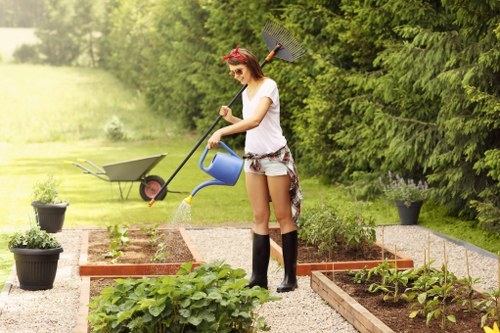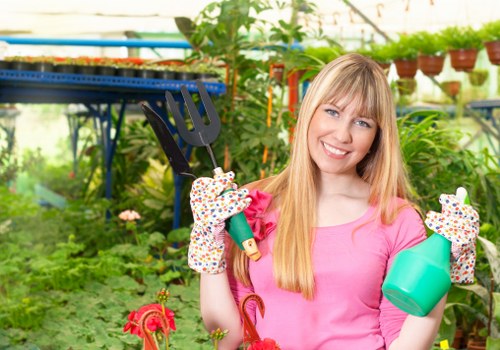Gardeners in Canary Wharf: Cultivating Green Spaces in the Heart of the City

Canary Wharf, known for its towering skyscrapers and bustling financial district, is also home to a surprising number of green spaces. Gardeners in Canary Wharf play a crucial role in maintaining these oases of tranquility amidst the urban jungle.
The demand for green areas in such a densely packed area has never been higher. Gardeners are not only responsible for the maintenance of parks and private gardens but also for creating sustainable environments that benefit both residents and the environment.
Why Gardening Matters in Canary Wharf
The Role of Gardeners in Urban Spaces

Urban gardening has become a vital component of city life. In Canary Wharf, gardeners work tirelessly to ensure that green spaces are not only beautiful but also functional.
They implement eco-friendly practices that reduce the carbon footprint of the area, manage waste effectively, and promote biodiversity.
Moreover, these green spaces provide a necessary respite for workers and residents alike, offering a place to relax and unwind after a busy day.
Key Responsibilities of Gardeners

- Plant Maintenance: Regular upkeep of plants, ensuring they are healthy and thriving.
- Landscape Design: Creating aesthetically pleasing and sustainable garden layouts.
- Pest Management: Using eco-friendly methods to control pests and diseases.
- Soil Management: Ensuring the soil is rich and fertile to support plant growth.
- Water Conservation: Implementing irrigation systems that minimize water usage.
Innovative Gardening Techniques in Canary Wharf

Gardeners in Canary Wharf are adopting innovative techniques to maximize green space efficiency. Vertical gardening, for instance, allows plants to grow upwards, saving valuable ground space.
Hydroponics and aeroponics are also becoming popular, enabling the cultivation of plants without soil, which is particularly useful in areas with limited ground space.
These methods not only enhance the beauty of Canary Wharf but also contribute to the local ecosystem by improving air quality and providing habitats for local wildlife.
Community Engagement and Education

Beyond maintenance and design, gardeners in Canary Wharf actively engage with the community. They organize workshops and educational programs to teach residents about sustainable gardening practices.
These initiatives foster a sense of community and encourage more people to participate in maintaining and enjoying their local green spaces.
Empowering the community with knowledge and resources ensures the longevity and health of Canary Wharf’s gardens.
Top 15 Nearby Areas to Canary Wharf for Gardeners
Canary Wharf is surrounded by several vibrant areas, each offering unique opportunities for gardeners:
- Stratford: Known for its expansive parks and community gardens.
- Greenwich: Features the beautiful Greenwich Park with diverse plant species.
- Poplar: Offers several urban gardens and green rooftops.
- Bow: Home to the Bow Bells Park, a favorite among local gardeners.
- Isle of Dogs: Contains numerous communal gardens and green spaces.
- Blackwall: Known for its waterfront gardens and botanical displays.
- Wapping: Features historic gardens with a modern twist.
- Lewisham: Offers extensive community gardening projects.
- Silvertown: Home to innovative urban farming initiatives.
- Rotherhithe: Boasts beautiful riverside gardens.
- Shadwell: Known for its lush green spaces and community involvement.
- Docklands: Features state-of-the-art green technology in gardens.
- Old Ford: Offers a mix of traditional and contemporary gardening styles.
- West India Dock: Known for its vibrant floral displays.
- East India Dock: Features serene gardens perfect for relaxation.
Challenges Faced by Gardeners in Canary Wharf
Despite the rewarding aspects, gardeners in Canary Wharf face several challenges:
- Space Limitations: Balancing green spaces with the ever-expanding urban infrastructure.
- Pollution: Managing the impact of air and noise pollution on plant health.
- Water Management: Ensuring efficient water use in an area with high demand.
- Climate Change: Adapting to changing weather patterns and their effects on gardening.
- Resource Allocation: Securing adequate resources for sustainable gardening practices.
Solutions and Innovations
To overcome these challenges, gardeners in Canary Wharf are adopting various solutions:
- Implementing green roofing and walls to increase plant coverage without taking up ground space.
- Using advanced irrigation systems that recycle water and reduce wastage.
- Incorporating native plant species that are more resilient to local climate conditions.
- Collaborating with environmental organizations to promote sustainable gardening practices.
- Investing in technology to monitor plant health and optimize growth conditions.
Future of Gardening in Canary Wharf
The future looks promising for gardeners in Canary Wharf. With increasing awareness of the importance of green spaces, there is a growing support for sustainable and innovative gardening practices.
Advancements in technology will continue to play a significant role, enabling gardeners to create more efficient and environmentally friendly gardens.
Community involvement will remain a cornerstone, ensuring that the gardens are maintained and cherished by all.
Opportunities for Aspiring Gardeners
- Workshops and Training: Numerous programs are available for those looking to enhance their gardening skills.
- Volunteer Programs: Opportunities to contribute to community gardens and green projects.
- Employment: Growing demand for professional gardeners in urban areas.
- Innovation: Encouragement to explore new gardening techniques and technologies.
Conclusion
Gardeners in Canary Wharf are essential in creating and maintaining green sanctuaries in one of London's most bustling districts. Their dedication and innovation not only enhance the beauty of the area but also contribute to the well-being of its residents and the environment.
As urban landscapes continue to evolve, the role of gardeners becomes increasingly vital in ensuring that cities like Canary Wharf remain vibrant, sustainable, and livable.
Frequently Asked Questions
1. What services do gardeners in Canary Wharf offer?
Gardeners in Canary Wharf provide a wide range of services, including plant maintenance, landscape design, pest management, soil management, and water conservation. They also offer community engagement programs and educational workshops on sustainable gardening practices.
2. How can I hire a gardener in Canary Wharf?
Hiring a gardener in Canary Wharf can be done through local gardening associations, online directories, or by seeking recommendations from neighbors and community groups. It's important to check their experience and specialties to ensure they meet your specific gardening needs.
3. What are the benefits of having a garden in an urban area like Canary Wharf?
Having a garden in an urban area like Canary Wharf provides numerous benefits, including improved air quality, enhanced aesthetic appeal, stress reduction, promotion of biodiversity, and offering a space for community interaction and relaxation.
4. Are there any community gardening projects in Canary Wharf?
Yes, Canary Wharf hosts several community gardening projects that encourage residents to participate in maintaining and enjoying local green spaces. These projects often include workshops, volunteer opportunities, and collaborative gardening activities.
5. What sustainable practices do gardeners in Canary Wharf follow?
Gardeners in Canary Wharf follow sustainable practices such as using eco-friendly pest control methods, implementing water-efficient irrigation systems, planting native species, promoting biodiversity, and utilizing green technologies like hydroponics and vertical gardening.